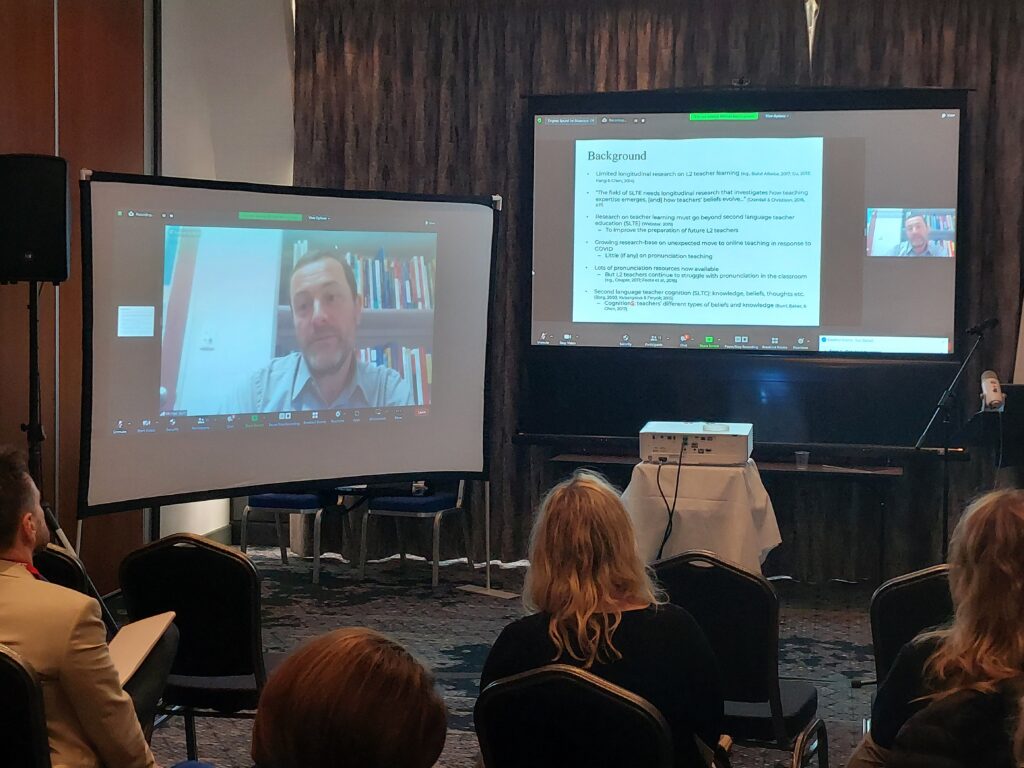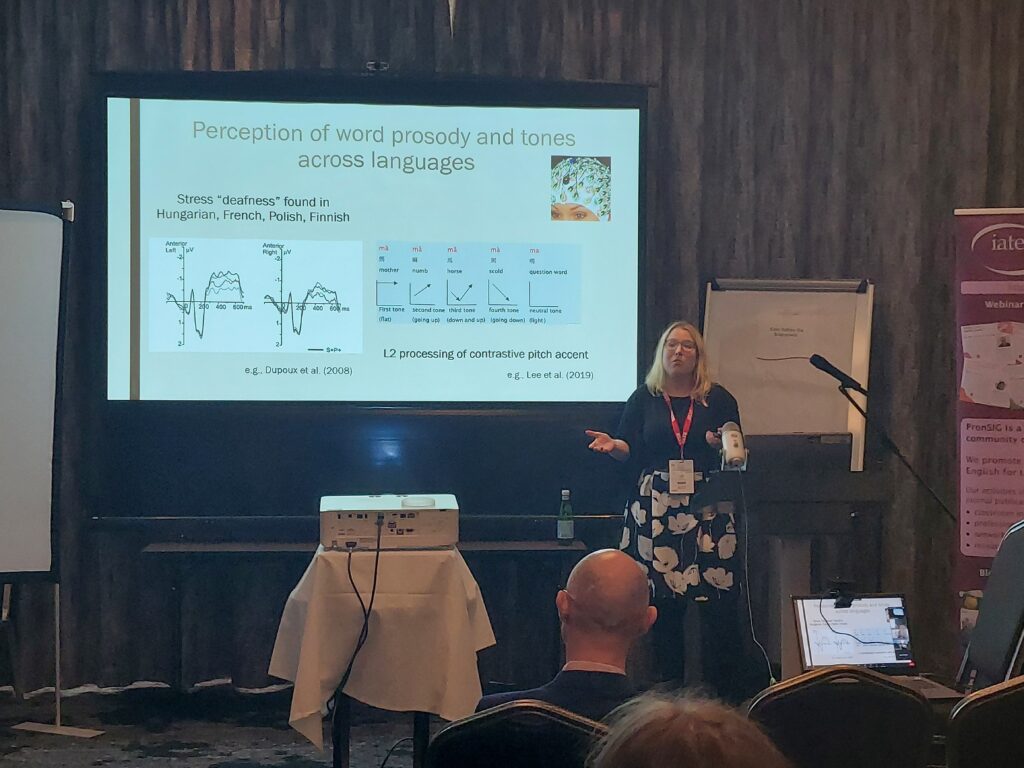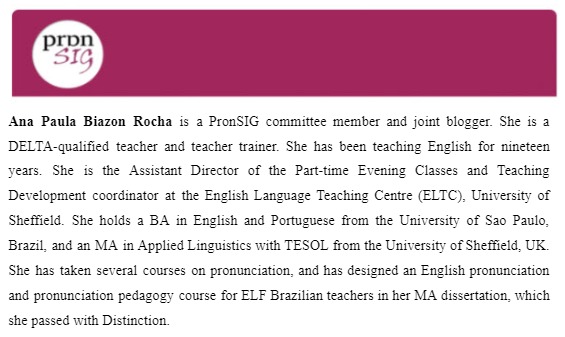by Ana Paula Biazon Rocha
Following-up from our May post, where we reflected on the highlights of Catarina Pontes and Mark Hancock’s sessions in PronSIG’s Pre-Conference Event (PCE) (17 Apr 2023), now it is time to turn to Michael Burri and Isabella Fritz’s sessions and review their key points. There is a lot of food for thought. Are you ready?
Learning to Teach Pronunciation
In our PCE opening session, Learning to teach Pronunciation: Insights from an 8-year Study, Michael Burri talked to us online straight from Australia. If you are not familiar with his research, Burri has published numerous studies on second language teacher cognition (SLTC) (Burri, 2015a, 2015b; Burri & Baker, 2019; Burri & Baker, 2020; Burri & Baker, 2021; Burri, Baker, & Chen, 2017, to name a few). He explains that cognitionS (with capital ‘S’) means teachers’ different types of beliefs and knowledge.
In his longitudinal study, he followed the trajectory of a group of teachers of English, from when they started to learn how to teach pronunciation in a pronunciation pedagogy course in 2013 to their return to face to face teaching, after being directly affected by the Covid-19 pandemic, in 2021.

Image 1: Michael Burri during his PCE presentation
Burri’s findings can be summarised as follows:
| 1. What does impact L2 teachers’ practices and cognitions about pronunciation? | – Mainly contextual factors such as students’ L1 and English level, time and curriculum constraints, and the Covid-19 pandemic, among others. |
| 2. What are some challenges teachers face when teaching pronunciation? | – Understanding learners’ needsGoing beyond controlled techniques such as ‘listen and repeat’ (for a review of the ‘listen and repeat’ teaching practice, check this blog post) – Extending oral corrective feedback past recasting and prompting during reading-aloud tasks (for a review of pronunciation correction techniques, check this blog post). |
| 3. What do teachers need to help them teach pronunciation? | – More training on the use of technology to teach pronunciation as well as on how to navigate different teaching contexts. |
Burri’s study is pivotal to help us understand ourselves as pronunciation teachers: what influences us, what challenges we face everyday, what we lack, what we abound, what we create, because teachers are not robots (or at least, ideally, they should not be!), they are thinking beings whose knowledge, beliefs and thoughts have an impact in the classroom as much as learners’.
Knowledge is power
Isabella Fritz’s Knowledge is power: How knowledge about prosody affects confidence in pronunciation teaching touched upon one of the main fears for many pronunciation teachers: prosody or suprasegmentals (for a review of what prosody is, check this blog post). In order to overcome such fear, she suggested that knowledge on Neurodidactics can be helpful. It refers to the use of findings from neuroscience and their application in the field of language teaching.
Initially, Fritz explained that very young infants are born ‘citizens of the world’ because they can discriminate between all sounds in the world’s languages. Consequently, children can acquire the phonemic contrast of all languages. Amazing, isn’t it? In contrast, it is hard for adults to produce phonological contrasts that they cannot perceive. For instance, if a learner’s L1 has no stress features such as those in English, it will be extremely difficult for them to produce the stress patterns of this language.

Image 2: Isabella Fritz during her PCE presentation
So, does that mean these adult learners will never learn stress in English? Not really! Fritz reminded us that word stress in English is somewhat systemic, despite contrary belief:
- with the suffixes -ion, -ic, stress is always on the penultimate syllable: election, activation, abbreviation
- with the suffix -ity, stress is always on the vowel before it: clarity, activity, university
- stress alternation in verbs and nouns: record (n.) and record (v.), torment (n.) and torment (v.)
Similar systematic approaches also occur in English rhythm, linking words, and intonation. Fritz also commented that in the classroom, an easy but extremely fruitful way of teaching these prosodic features is using gestures (for a review of how to use your hands to teach pronunciation, check our very first blog post).
Therefore, she showed us that pronunciation features are not as arbitrary or ‘nearly impossible’ to grasp as one might think. The more knowledgeable teachers are about neurodidactics, phonetics and phonology, the more they can understand what prosody entails and its importance when it comes to intelligibility. It seems to be commonplace for many teachers to over rely on segmental features when teaching pronunciation, masking a possible uncertainty and/or lack of confidence to teach prosodic features.
Nevertheless, acquiring such knowledge and learning how to transform it into effective teaching practices to benefit learners are challenges that most of us face, which ties us back to one of Burri’s research findings: the need for more training and access to Pronunciation Instruction. That is why PronSIG has always been intent on reaching teachers all over the world and contributing to their pronunciation teaching. Events such as the PCE are a great opportunity for that.
A big thanks to our four wonderful speakers (Burri, Pontes, Fritz and Hancock), to all of those who joined face to face or online, and to you who are reading this blog post. Help us spread the word and let other teachers know about our blog and the extensive variety of tips, ideas, discussions and reflections we have gathered so far.
Don’t forget to follow PronSIG on social media and leave your comments below. See you in July!
References
Burri, M. (2015a). ‘“My perspective changed dramatically”: A case for preparing L2 instructors to teach pronunciation’, English Australia Journal, 31(1), p. 19-37.
Burri, M. (2015b). ‘Student teachers’ cognition about L2 pronunciation instruction: A case study’, Australian Journal of Teacher Education, 40(10), p. 66-87.
Burri, M., & Baker, A. (2019). ‘“I never imagined” pronunciation as “such an interesting thing”: Student teacher perception of innovative practices’, International Journal of Applied Linguistics, 29(1), p. 95-108.
Burri, M., & Baker, A. (2020). ‘“A big influence on my teaching career and my life”: A longitudinal study of L2 pronunciation teacher development’, TESL-EJ, 23(4).
Burri, M., & Baker, A. (2021). ‘“I feel … slightly out of touch”: A longitudinal study of teachers learning to teach English pronunciation over a six-year period’, Applied Linguistics, 42(4), p. 791–809.
Burri, M., Baker, A., & Chen, H. (2017). ‘ “I feel like having a nervous breakdown”: Pre-service and in-service teachers’ developing beliefs and knowledge about pronunciation instruction’, Journal of Second Language Pronunciation, 3(1), p. 109-135.



Dear Ana,
I thank you so much for spreading the word through this blog. I’m a teacher in Brazil and I’ve been able to get the latest news on Pronunciation through PRONSIG blog. Pronunciation definitely makes a different in our speaking and it should be thoroughly taught – learning how to teach and getting more information are ways to build up our confidence to deal with pronounciation, whether in terms of correction or a specific teaching point.
Many thanks, Rezinha.
We’re glad to hear you’ve been enjoying our blog and that it’s been a useful experience for you.
Best, 🙂
Ana.